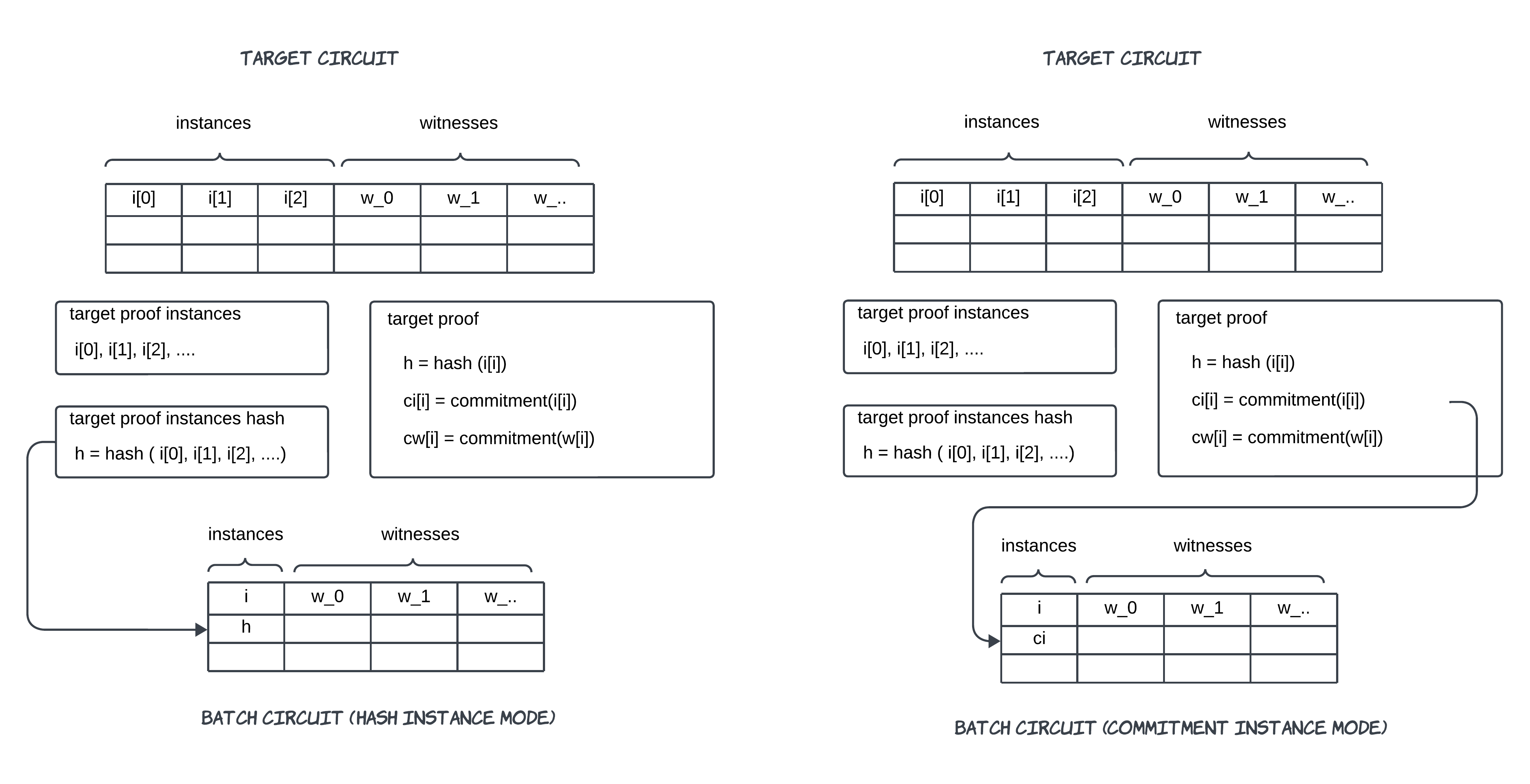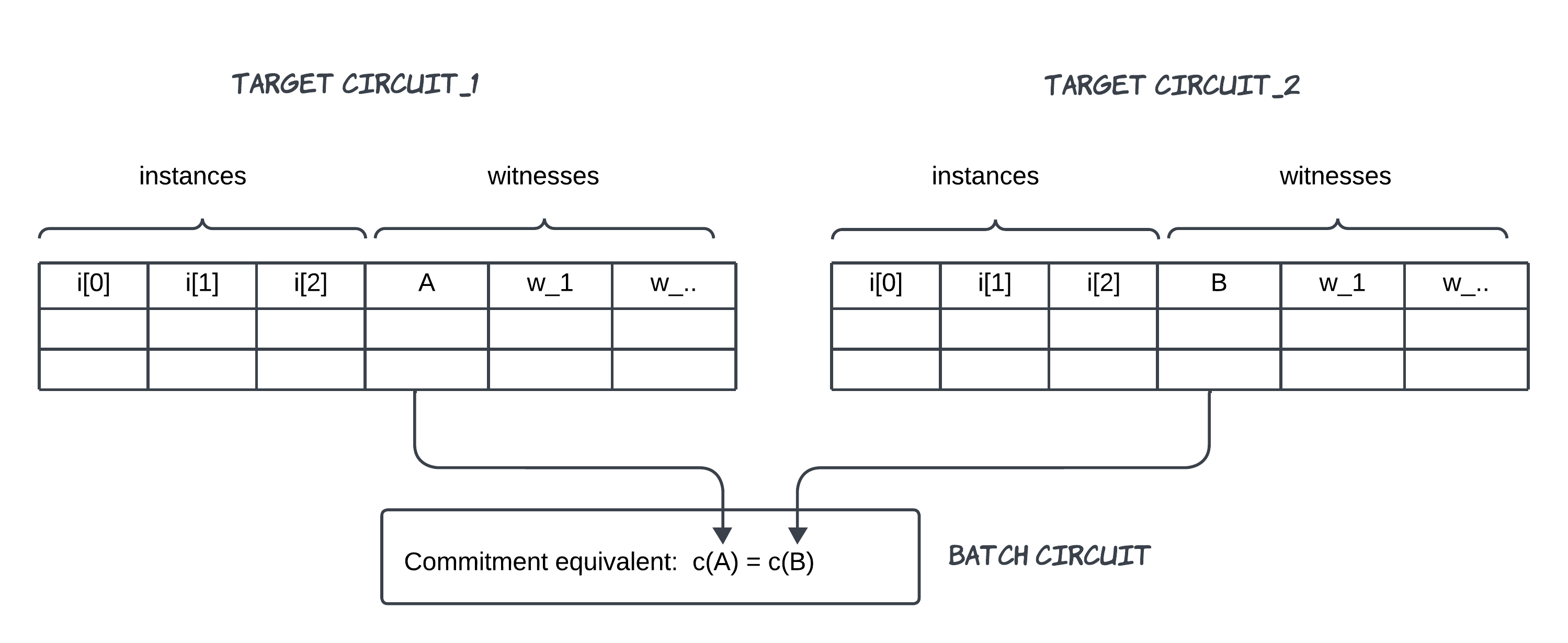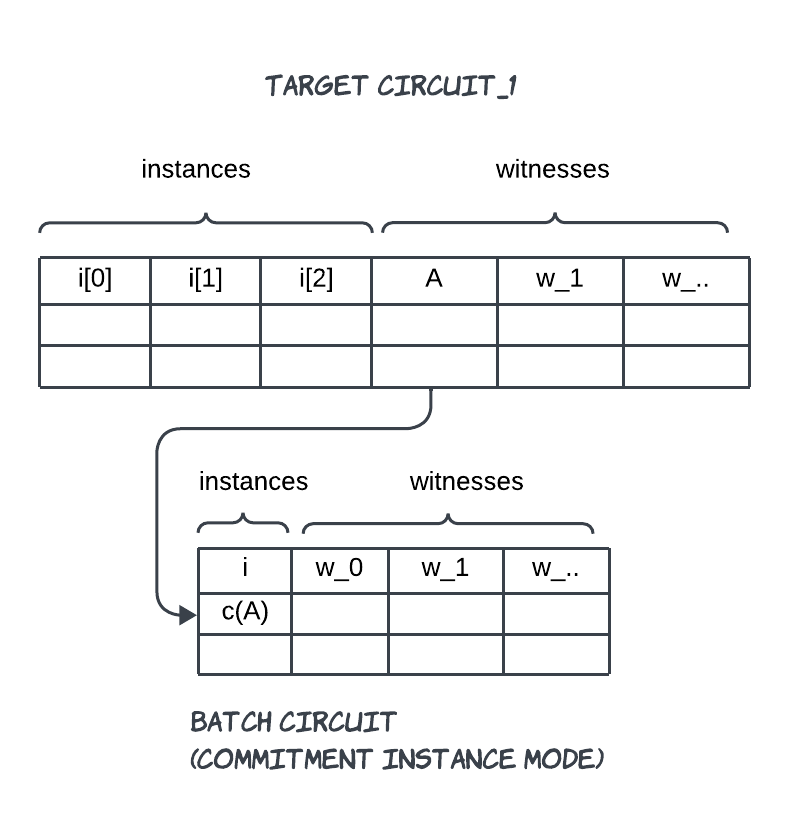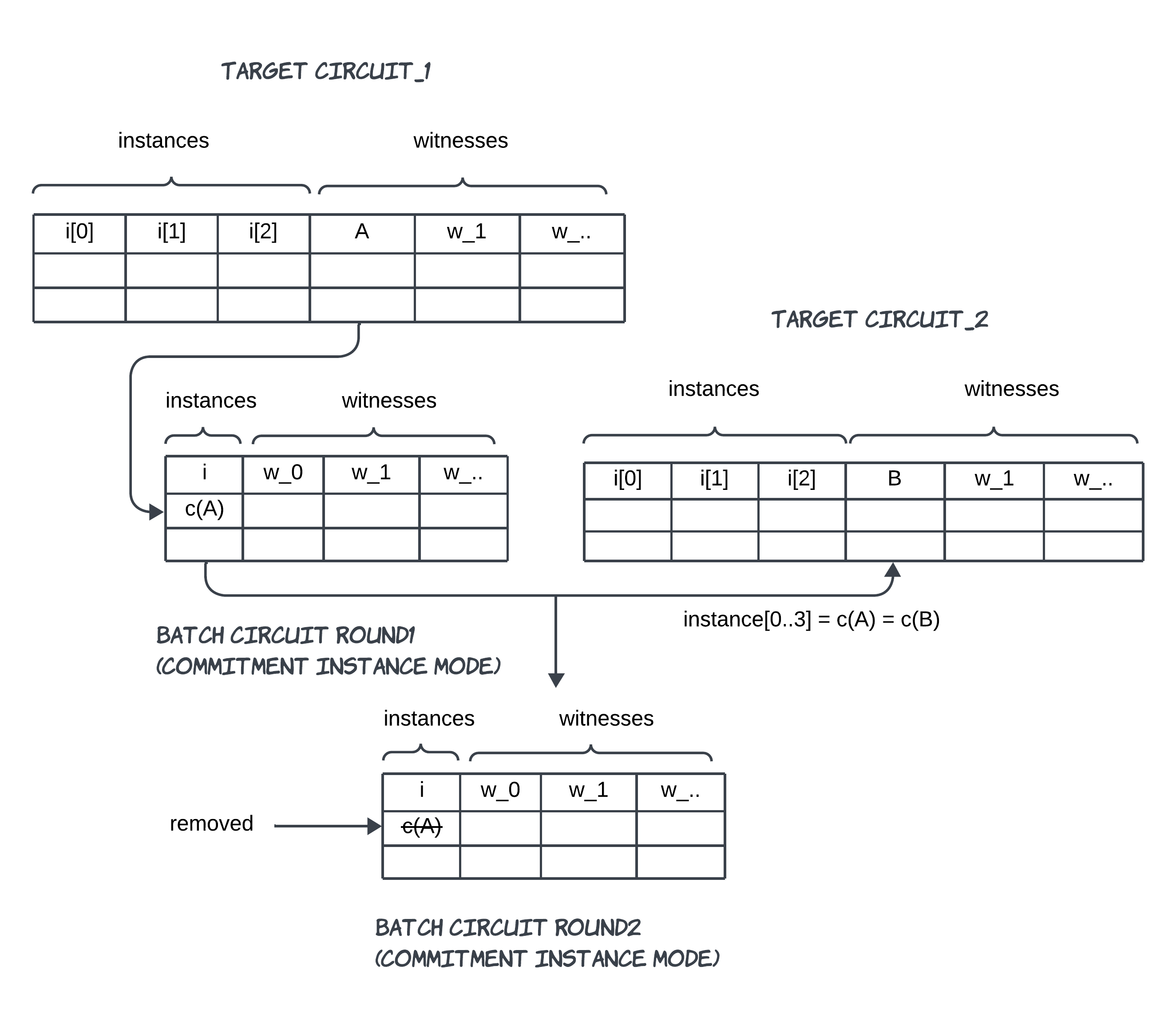Delphinus-zkWASM supports a continuation protocol by providing columns of witnesses that represent the VM state. So that the execution of a large trace can be split into multiple code traces and the following trace can access the previous stack and memory. The whole process works similar to a context store/restore in a standard operation system. The basic idea is to track the commitment of the context column stored in the proof transcript and then provide a configurable circuit component in the proof batcher to reason about different commitments between proofs. In the case of ZKWASM continuation implementation, when the proof-batcher batches a continuation flow of proofs, it checks that the input context commitment is equal to the output context commitment of the previous context.
Although the tool is initially developed for a specific ZKVM (ZKWASM), it can be used to batch all KZG-based proofs and the DSL used to reasoning about the commitments and instances still work. Also, it can be used to support different continuation schemas (eg. flat continuation, rollup continuation) and rollup schemas (eg. layered batching, accululator batching).
At the end, we provide a solidity generation tool for your final round of batching script so that the proof you generated after executing the batching DSL can be verified on the chain and we also provide a demo tracking contract with which you can check whether a single proof has been involved in a large batched proof (inclusive proof of the batched proof).
We support two modes of batching proofs. The rollup continuation mode and the flat mode. In both mode we have two options to handle the public instance of the target proofs when batching.
- The commitment encode: The commitment of the target instance becomes the public instance of the batch proof.
- The hash encode: The hash of the target instance become the public instance of the batch proof.
Meanwhile, we provide two openschema when batching proofs, the Shplonk and GWC and three different challenge computation methods: sha, keccak and poseidon. (If the batched proofs are suppose to be the target proofs of another round of batching, then the challenge method needs to be poseidon.)
The general usage is as follows:
cargo run --release -- --params [PARAMS_DIR] --output [OUTPUT_DIR] [SUBCOMMAND] --[ARGS]
where [SUBCOMMAND] is the command to execute, and [ARGS] are the args specific to that command.
The --output arg specifies the directory to write all the output files to and is required for all commands.
The --params arg specifies the directory to write all the params files to and is required for all commands.
USAGE:
circuit-batcher batch [OPTIONS] --challenge <CHALLENGE_HASH_TYPE>... --openschema <OPEN_SCHEMA>...
OPTIONS:
-a, --accumulator [<ACCUMULATOR>...]
Accumulator of the public instances (default is using commitment) [possible values:
use-commitment, use-hash]
-c, --challenge <CHALLENGE_HASH_TYPE>...
HashType of Challenge [possible values: poseidon, sha, keccak]
--commits <commits>...
Path of the batch config files
--cont [<CONT>...]
Is continuation's loadinfo.
-h, --help
Print help information
--info <info>...
Path of the batch config files
-k [<K>...]
Circuit Size K
-n, --name [<PROOF_NAME>...]
name of this task.
-s, --openschema <OPEN_SCHEMA>...
Open Schema [possible values: gwc, shplonk]
Example:
#! /bin/bash
params_dir="./params"
output_dir="./output"
if [ ! -d "$params_dir" ]; then
# If it doesn't exist, create it
mkdir -p "$params_dir"
else
echo "./params exists"
fi
if [ ! -d "$output_dir" ]; then
# If it doesn't exist, create it
mkdir -p "$output_dir"
else
echo "./output exists"
fi
# Get the resource ready for tests
cargo test --release --features cuda
# verify generated proof for test circuits
cargo run --release --features cuda -- --params ./params --output ./output verify --challenge poseidon --info output/test_circuit.loadinfo.json
# batch test proofs
cargo run --features cuda -- --params ./params --output ./output batch -k 22 --openschema shplonk --challenge keccak --info output/test_circuit.loadinfo.json --name batchsample --commits sample/batchinfo_empty.json
# verify generated proof for test circuits
cargo run --release --features cuda -- --params ./params --output ./output verify --challenge keccak --info output/batchsample.loadinfo.json
# generate solidity
cargo run --release -- --params ./params --output ./output solidity -k 22 --challenge keccak --info output/batchsample.loadinfo.json
- Describe circuits.
- Generate the proofs of target circuits.
- Define your batching policy via the batch DSL.
- Execute the batching DSL and generate the batching circuit.
- Generate the final solidity for your batching circuit.
To describe a proof, we need to specify (in file name)
- The circuit this proof related to.
- The instance size of the proof.
- The witness data if the proof have not been generated yet.
- The proof transcript.
type ProofPieceInfo = {
circuit: filename,
instance_size: int,
witness: filename,
instance: filename,
transcript: filename
}
To batch a group of proofs together, the proofs themself need to be generated using the same param k (not necessarily the same circuit). When describing the group we provide the following fields:
type ProofGenerationInfo {
proofs: Vec<ProofPieceInfo>
k: int
param: filename,
name: string,
hashtype: Poseidon | Sha256 | Keccak
}
This tool requires the target proofs (the proofs we want to batch) are all uses the Poseidon as hash functions for challenge generation. If the batch circuit is used to generate intermediate proofs for another batching circuit, then we need to specify the batch circuit to use the Poseidon hash for challenge generation as well. If the batch circuit is used to generate a final proof for verification on chain, then you should specify the challenge hash to be either Keccak or Poseidon.
Suppose that we would like to batch our target proofs T_i, the batching circuit is C_b, the verifier of C_b is V_b and our batched proof is called proof B. If is important to understand the instance structure of C_b.
In this tool, we support two accumulator modes to pass the information of the instance of T_i to the instance of C_b, namely in HashInstance mode and CommitInstance mode.
When batch proofs, we are in fact writing the verifying function into circuits. Thus we need to specify the components of the circuits we used to construct the final verifying circuit. The main components of the verifing circuit contains the challenge circuit (the hash we use to generate the challenge), the ECC circuit (what is used to generate msm and pairing), the proof relation circuit (what is used to describe the relation between proofs, their instances, commitments, etc)
- The challenge circuit has three different type
hashtype: Poseidon | Sha256 | Keccak
-
The ECC circuit has two options. One is to use the ECC circuit with lookup features. This circuit can do ECC operation with minimized rows and thus can be used to batch a relatively big amount of target circuits. The other option is to use a concise ECC circuit. This circuit do not use the lookup feature and thus generates a lot of rows when doing ECC operation. This ECC circuit is usually used at the last round of batch as the solidity for this circuit is much more gas effective.
-
The proof relation circuit is configurable. It can be described in a JSON with commitment arithmetic and the commitment arithmetic has three categories: equivalents, expose and absorb.
Example: A simple proof relation sheet with commitment arithmetic
{
"equivalents": [
{
"source": {"name": "circuit_1", "proof_idx": 0, "column_name": "A"},
"target": {"name": "circuit_2", "proof_idx": 0, "column_name": "B"}
}
],
"expose": [
{"name": "test_circuit", "proof_idx": 0, "column_name": "A"}
],
"absorb": []
}
There are a few scenarios we need to specify the constraints between commitments of different proofs.
Suppose that we have two circuits, circuit_1 and circuit_2, they both have instances and witnesses namely instances_1, instances_2, witness_1, witness_2. It follows that, after batching the proofs, we lose the information of witness_1 and witness_2. Thus to establish the connection between witness_1 and witness_2 we provide a configurable component in the batching circuit that allows user to specify equivalents between columns of witness_1 and witness_2. when we put the following configuration into the proof relation sheet
{
"equivalents": [
{
"source": {"name": "circuit_1", "proof_idx": 0, "column_name": "A"},
"target": {"name": "circuit_2", "proof_idx": 0, "column_name": "B"}
}
],
}
the batch will ensure the witness of column A of the first proof of circuit_1 will equal to the witness of column B of the first proof of circuit_2.
Suppose that we have two groups of proofs that batched into batch_proof_1 and batch_proof_2 where batch_proof_1 contains proofA and batch_proof_2 contains proofB. It follows that we can not establish connections between the witness of proofA and proofB when batching batch_proof_1 and batching_proof_2 because batch_proof_1 lost the track of witness of proofA and batch_proof_2 lost the track of witness of proofB. Thus to solve this problem, we provide the expose semantics when batching batch_proof_1 and batch_proof_2. For example, if we want to constraint that witness column A of proofA is equal to the witness column B of proofB, we can first expose A of proofA in the proof relation sheet of batch_proof_1 as follows
{
"expose": [
{
{"name": "circuit_1", "proof_idx": 0, "column_name": "A"},
}
],
}
and then expose B in the proof relation sheet of batch_proof_2. The expose of the witness will append three new instances to the instances of the batched proof which represents the commitment of the witness.
Suppose that we have a batched proof batch_proof_1 which contains proof_1 and another proof proof_2. Then it follows that if we would like to establish a connection between witness A of proof_1 and witness B of proof_2, we need not only expose A in the proof relation sheet of batch_proof_1 but also provide a semantic for the batcher to ensure that the exposed commitment of A is equal to the commitment of B in proof_2. Since proof_2 has not been batched yet, neither equivalents nor expose will work. Thus, we need a new semantic called absorb here.
"absorb": [
{
"instance_idx": {"name": "single", "proof_idx": 1, "group_idx": 2},
"target": {"name": "single", "proof_idx": 0, "column_name": "post_img_col"}
}
]



